The people getting rich off the discards of our addiction
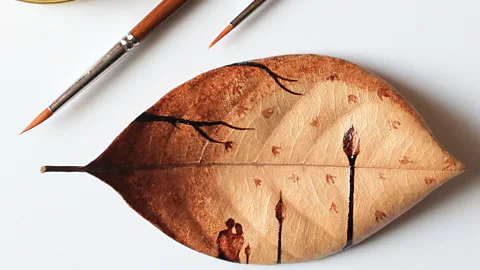 Ghidaq al-Nizar
Ghidaq al-NizarIt's not the cuppa itself, but the grounds we toss away as rubbish. Coffee socks, anyone?
Desperate for our morning coffee fix, most of us are blind to the mammoth mounds of messy wet grounds left behind. But some people — from engineers to designers — have found novel ways to reap financial rewards from the waste left behind by our coffee obsession.
Holding the brew
Five years ago, as a product design student in Italy, Julian Lechner was on his fifth espresso when he decided to focus his final design-school project on how to recycle the leftover grounds into new materials. Today, in Berlin, Germany, Lechner has produced a substance suitable for manufacturing dishwasher-safe coffee cups and saucers. Yes, from coffee grounds.
 Copyright Images Kaffeeform
Copyright Images Kaffeeform“They have a slight coffee scent which lasts for a couple of weeks,” says the 30-year-old designer, who charges 19.90 euros ($22) for an espresso cup and saucer, and 24.90 euros ($28) for a cappuccino size set. “But they don’t taste like coffee. You could have a cup of tea and it would taste like tea.”
Lechner gave up a job in design to found his company, Kaffeeform, about a year ago with around 40,000 euros ($44,717) in private financing. He now employs eight staff and is “almost breaking even”, he says. At present, the company collects 500 kg (1,102 lbs) of used coffee grounds a month for free, from cafes within walking distance of their premises in the trendy Berlin neighbourhood of Kreuzberg.
“Six servings of coffee are enough for us to make another coffee cup,” he says. “As we make more volume we will lower the price [of the cups] step by step. For the future we’d like to go into mass production. There’s a lot of coffee waste out there.”
Good-bye smelly feet
Wearing footwear made from coffee grounds might sound a step too far. But there’s a practical reason, according to Aman Advani, CEO and co-founder of Massachusetts-based apparel firm Ministry of Supply.
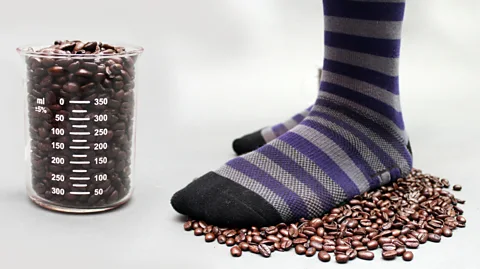 Ministry of Supply
Ministry of SupplyPreviously a business consultant, clocking up thousands of air miles, Advani hated how formal dress socks left his feet clammy at the end of long days. So he cut off the upper tube of a dress sock and stitched it to the sweat-absorbent sole of an athletic sock to make his first “performance dress sock.” From there, the coffee idea wasn't far off.
Then in 2012, he and fellow graduates from MIT university set up menswear label Ministry of Supply in Cambridge, Massachusetts, in the US, with $8.5m of private funding. Customers told them that one of their biggest issues with socks was smelliness.
“Coffee was a natural and powerful solution — nothing could compete,” says 31-year-old Advani. “When you go to a department store’s fragrance section, you’ll see coffee beans on the counters to cleanse your nasal palate. Coffee actually neutralises odours.”
Launched on Kickstarter three years ago, their Atlas Series dress socks, incorporating 40% coffee-infused recycled polyester, won crowdfunding of $204,601. Retailing for $15 a pair, they are now one of their most popular lines, Advani says. The carbonized grounds, reclaimed from coffee roasters and shops, go through a pharmaceutical process to remove the oils before being infused into the fibres of recycled polyester yarn.
“We recommend treating them like your typical sock and washing after every wear. But we’ve heard that you can wear the socks for a week without much of a smell,” he says.
Spinning a new yarn
You may already be wearing waste coffee — or at least yarn made with it — next to your skin. American Eagle, Timberland and L.L. Bean are among 110 fashion labels who work with S. Cafe fabric, made from yarn containing 1.2 to 1.5% coffee ground nano particles.
Used mainly for sportswear, but also underwear and fashion clothing, it is supplied by Taiwanese textile makers Singtex, a firm with revenue last year of $45m, of which S.Cafe accounted for $7.4m.
The New Taipei City-based family firm invested $2.2m and four years in developing S.Cafe sustainable coffee yarn. The idea came from the company's chairman Jason Chen, who spotted serious commercial potential after overhearing a patron at a local coffee shop request used grounds to take home for their deodorising qualities.
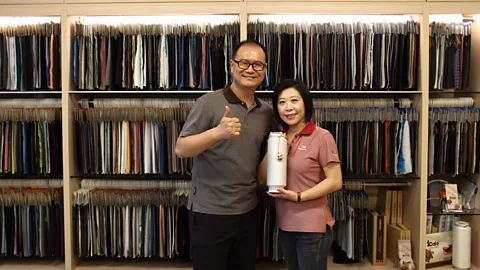 Singtex
Singtex“Upon seeing this, [his wife] Amy jokingly told Jason that … he should put coffee grounds in his clothes so he would be less of a ‘smelly man’ [after sports],” says Mosa Wong, deputy section marketing manager of Singtex. And what started as an inside joke, grew into something more.
Singtex now uses about 500 kg (1,102 lbs) of used coffee grounds daily to produce its range of S. Cafe fabrics. “We collect free coffee grounds from different coffee shops. These coffee shops are happy to give us grounds for free to save money on waste disposal," Wong says.
Firing up the grill
The leftovers from your latte also can now become logs to fire up your barbecue. The sausage-shaped briquettes are the latest product from bio-bean, a UK-based clean technology firm which processes 50,000 tonnes of coffee grounds annually at their recycling plant in Cambridgeshire.
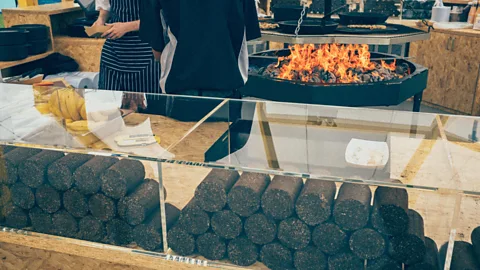 bio-bean
bio-beanThe carbon-neutral logs are made almost entirely of waste grounds but burn with no hint of coffee aroma, says 25-year-old Arthur Kay, bio-bean founder and CEO. “We do use some natural organic binding agent to increase the durability and hold them together because coffee is obviously lots of very small particles.”
Kay came up with the concept three years ago, while he was an architecture student designing a coffee shop. Spotting the volume of grounds disposed of, he hit upon the idea of transforming them into carbon-neutral biofuels. With financing of under £10m ($13.3m) from a mix of private and state sources, bio-bean now employs 30 staff, he says.
They collect the grounds from thousands of coffee shops and restaurants as well as from instant coffee factories, airports and train stations. Firms hand them over for free because it saves money on waste disposal. The resulting coffee logs will go on sale in supermarkets, garden centres and garage forecourts in the UK this autumn.
“Coffee Logs serve as a direct replacement for fossil fuels and woody biomass, burning longer and hotter than wood, thereby saving consumers money on a kilo by kilo basis,” Kay says.
Sprucing up the garden
When UK-based coffee company Greencup was looking at recycling ideas, it delved into the oft-quoted gardening tip that spent coffee grounds can perk up soil.
“British people are the most famous gardening hobbyists in the world so a garden product was a fantastic way of engaging people with the idea of recycling coffee waste,” says Greencup’s innovations director Adam Fairweather.
After several years of research, working with Imperial College London, and botanical gardens, the firm came up with a 100% organic fertiliser and slug repellent. It’s made from coffee waste collected from Greencup’s coffee customers — 200 to 300 tonnes annually — mixed with other natural ingredients like bracken and wood ash, and has high grade certification from the British Biochar Foundation.
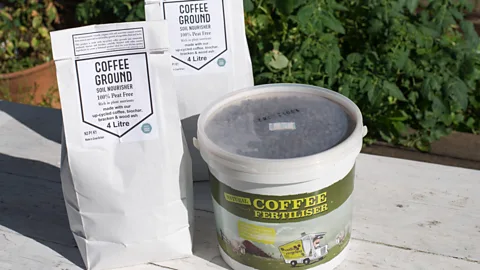 Greencup
GreencupGreencup’s Coffee Grounds Soil Nourisher sells for £7 per four litres ($9.19) through garden centres, and a five-litre-pot of Greencup pelleted coffee soil conditioner costs £10 ($13.13). The London-based £2m-a-year revenue company says it donates profits from the fertiliser to charity.
Showing off the sparkle
After a full day wearing her own handmade rings, Rosalie McMillan occasionally catches a faint aroma of coffee wafting from her fingers. That’s because the UK-based jewellery maker creates pieces containing 70% recycled coffee grounds, collected mostly from offices in London. Her formula includes ground-up pieces of the jute sacks coffee comes in, plus a bio resin as binder.
“It seems a very, very odd material to work with to most people but to me it’s natural,” says 33-year-old McMillan, a partner in a plastics-recycling firm. “It’s a wonderful material because it has such a resonance with people across the world.”
For her latest collection, Java Ore, she used the coffee material with sterling silver and gold leaf to create necklaces, bangles, rings and ear rings.
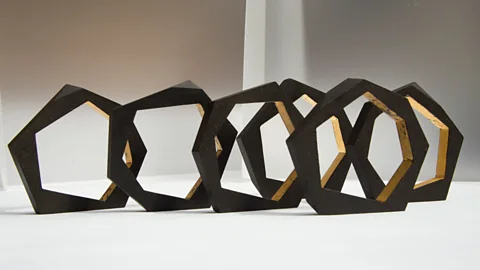 Rosalie McMillan
Rosalie McMillanMcMillan has been crafting jewellery for many years and two years ago invested a few thousand pounds, she says, into turning it into a business. She sells online and also through a few stockists in the UK, including a boutique in London’s jewellery quarter, Hatton Garden. Her pieces range in price from £83 ($108) for a Java Rock ring with 22ct gold leaf to £468 ($607) for a Java Rock large statement necklace made with recycled sterling silver and gold leaf.
Coffee art
Bored with a barista tracing yet another fern-shaped rosetta pattern in his coffee foam, Ghidaq al-Nizar started creating his own latte art at home. But then one morning the Indonesian artist, who lives in Bandung, West Java, pressed the idea further.
“I was too lazy to make milk foam for etching my coffee. I went to the kitchen, made a cup of ground coffee. When I came to the bottom of the cup, I saw the grounds,” says the 27-year-old. “I imagined Grim was there, a fictional creature from Harry Potter. My mind and hands began to work on them.”
 Ghidaq al-Nizar
Ghidaq al-NizarWorking with a paint brush and tooth pick on ceramics, melamine and dry leaves, he started using coffee grounds, and a few drops of coffee stain, and glue, to create delicate works of art. As an environmentalist, he’s glad to be reusing food waste — about two spoonfuls of grounds for each piece.
His Zero Waste Coffee Art has won him more than 45,000 Instagram followers and been exhibited in the Indonesian capital of Jakarta. He sells his creations to collectors, mainly online, for between $150 and $780.
“Why coffee? Because I fell in love with it,” he says. “Coffee means celebration! I really want people to at least catch the simplest meaning of what I’m doing [which is] that it is not about how talented we are. It is about how we love things we love and how we celebrate our lives with it, to love more, to spread more peace. Enjoy every drop of your coffee!”
